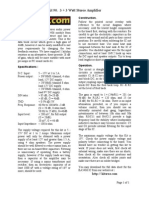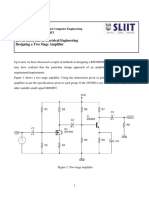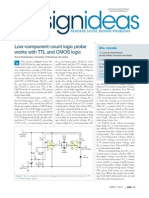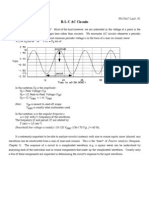Capacitor Response To Square Wave
Capacitor Response To Square Wave
Uploaded by
Atul SotiCopyright:
Available Formats
Capacitor Response To Square Wave
Capacitor Response To Square Wave
Uploaded by
Atul SotiOriginal Description:
Original Title
Copyright
Available Formats
Share this document
Did you find this document useful?
Is this content inappropriate?
Copyright:
Available Formats
Capacitor Response To Square Wave
Capacitor Response To Square Wave
Uploaded by
Atul SotiCopyright:
Available Formats
Response to ideal square wave signal
Capacitor:
Consider a simple RC circuit which all of us must have seen before. By simply applying Kirchoffs Law we can find out the relationship between applied voltage, current and voltage across capacitor ( Vc ) , Where Therefore,
dq (t ) q (t ) V (t ) + = dt RC R
dt To solve the above differential equation multiply both sides by e RC = et / RC . We get 1
V (t ) i (t ) R Vc (t ) = 0 q (t ) dq(t ) and i = Vc (t ) = C dt
q (t )et / RC =
1 V (t )et / RC dt R
For V (t ) = V0 with initial condition Vc (t = t0 ) = Vc 0 , we get
Vc (t ) = V0 1 e ( t t0 )/ RC + Vc 0 e (t t0 )/ RC
For V (t ) = mt with initial condition q (t = 0) = 0 , we have
q (t ) = CV (t ) ( mRC 2 ) (1 e t / RC )
Vc (t ) = V (t ) (mRC ) (1 e t / RC )
This is the response of capacitor for a linear wave. Now consider a pulse with very high value of m which rises to some finite value, say V0 , in very short interval t0 . Putting the series form of exponential, 1 1 Vc (t0 ) = V (t0 ) (mRC ) 1 1 t0 / RC + (t0 / RC ) 2 (t0 / RC )3 + ... 2! 3!
1 t0 1 t0 2 Vc (t0 ) = V0 + ... 2 3 2! ( RC ) 3! ( RC ) By taking the limit m tending to infinite and therefore t0 tending to zero one finds Vc (t0 ) = 0 .
Now consider an ideal square wave of 50% duty cycle with time period 2T. By ideal we mean that the time for switching from one voltage level to another is zero (infinite m).
As shown above, capacitor doesnt respond to such pulse of infinite m. Therefore we can think of square wave as a DC source with voltage
V V (t ) = 0 V0
For n = 0, 2, 4..
for nT < t (n + 1)T for (n + 1)T <t (n + 2)T
Vc [( n + 1)T ] = V0 (1 e T / RC ) + Vc [nT ]e T / RC Vc [(n + 2)T ] = V0 (1 e T / RC ) + Vc [(n + 1)T ]e T / RC
By combining above two equations we get,
Vc [(n + 2)T ] = V0 (1 e T / RC ) 2 + Vc [ nT ]e 2T / RC Putting n = n-2, n-4 ...2, 0 in equation (0) Vc [ nT ] = V0 (1 e T / RC ) 2 + Vc [( n 2)T ]e 2T / RC
T / RC 2 2T / RC
..0
.1
.2 Vc [(n 2)T ] = V0 (1 e ) + Vc [( n 4)T ]e ............... .. Vc [( n 2k + 2)T ] = V0 (1 e T / RC ) 2 + Vc [( n 2k )T ]e 2T / RC .k
Vc [2T ] = V0 (1 e T / RC ) 2 + Vc [0]e 2T / RC
n/2
Multiplying kth equation by e 2 kT / RC and adding
Vc [( n + 2)T ] = V0 (1 e T / RC ) 2 {1 + e 2T / RC + e 4T / RC + ... + e nT / RC } + Vc [0]e ( n + 2)T / RC
(1 eT / RC ) 2 Vc [(n + 2)T ] = V0 (1 e ( n + 2)T / RC ) + Vc [0]e ( n + 2)T / RC 2T / RC (1 e ) For the limit n
(1 e T / RC )2 (1 e2T / RC ) This is the steady-state peak voltage across capacitor. Now, Vc [] = V0 d Vc [] 2e T / RC (1 eT / RC ) 2 = dT V0 RC (1 e2T / RC ) 2 = +ve T > 0 Therefore Vc [] increases with T. Also,
Vc [] = V0 / 2 for T = RC ln 3
You might also like
- The Cascode Amplifier: DC ACDocument8 pagesThe Cascode Amplifier: DC ACRamanaButterfly86% (7)
- Electrical and Information Engineering University of Sydney: ELEC3405/5738 Communications Electronics and PhotonicsDocument29 pagesElectrical and Information Engineering University of Sydney: ELEC3405/5738 Communications Electronics and PhotonicssakilakumaresanNo ratings yet
- Electronics - and - Telecommunications - Noise, F R CONNOR PDFDocument143 pagesElectronics - and - Telecommunications - Noise, F R CONNOR PDFAjay VarmaNo ratings yet
- A3 Ace 1KM 1KTDocument1 pageA3 Ace 1KM 1KTPatricio GomezNo ratings yet
- User Manual - User Manual - Original and Genuine Veronica® 1W PLL (1WPLLM)Document39 pagesUser Manual - User Manual - Original and Genuine Veronica® 1W PLL (1WPLLM)Carlos Evangelista SalcedoNo ratings yet
- Experimenting With The Picbasic Pro CompilerDocument188 pagesExperimenting With The Picbasic Pro Compilerjfg8721100% (2)
- JDS6600 EN ManualDocument20 pagesJDS6600 EN Manualq1w2No ratings yet
- Schematic 0G 00005677 Mod Dimmer 5A 1L PDFDocument1 pageSchematic 0G 00005677 Mod Dimmer 5A 1L PDFvictor maurizioNo ratings yet
- LCD Interfacing With SPARTAN-3 FPGADocument12 pagesLCD Interfacing With SPARTAN-3 FPGAKaranNo ratings yet
- ECA All UnitsDocument194 pagesECA All UnitsREMALLI KeerthiNo ratings yet
- Chapter 7Document23 pagesChapter 7enes_ersoy_3No ratings yet
- ES-1 Natural and Forced ResponseDocument39 pagesES-1 Natural and Forced ResponseGanesh DharmireddyNo ratings yet
- 2-Dieu Che Tuong TuDocument136 pages2-Dieu Che Tuong TuAnhTưNo ratings yet
- Lab Assignment 8: 1 Sequential Circuit DesignDocument2 pagesLab Assignment 8: 1 Sequential Circuit DesignRehan bhattiNo ratings yet
- ESC201T L11 RLC CircuitsDocument31 pagesESC201T L11 RLC CircuitsRachit MahajanNo ratings yet
- Natural and Step Response of Series andDocument71 pagesNatural and Step Response of Series andManar HosnyNo ratings yet
- RLCDocument49 pagesRLCVandana AppalaRaju100% (1)
- Op Amp NotesDocument34 pagesOp Amp NotesUma ShankarNo ratings yet
- Introduction To Second Order Circuit: Natural Response of RLC CircuitDocument34 pagesIntroduction To Second Order Circuit: Natural Response of RLC CircuitSyed AbdullahNo ratings yet
- Lecture 5 - Biopotential MeasurementsDocument59 pagesLecture 5 - Biopotential Measurementsapi-27535945100% (2)
- Cs Imp QuestDocument3 pagesCs Imp QuestLordwin MichealNo ratings yet
- Signals and Systems - S. GhoshDocument53 pagesSignals and Systems - S. GhoshbnatarajNo ratings yet
- 12 Bit Spi Adc: Adc Pin Spartan3E FPGA LinesDocument6 pages12 Bit Spi Adc: Adc Pin Spartan3E FPGA LineskaankandemirrrNo ratings yet
- Kit 90. 3 + 3 Watt Stereo Amplifier: ConstructionDocument3 pagesKit 90. 3 + 3 Watt Stereo Amplifier: ConstructionRiktam BasakNo ratings yet
- N5625Document286 pagesN5625Feliscio Ascione FelicioNo ratings yet
- A3 Ace 3KM 1KT 2mot 4FCDocument1 pageA3 Ace 3KM 1KT 2mot 4FCellaneroNo ratings yet
- Chapter 6 Digital Transmission PDFDocument45 pagesChapter 6 Digital Transmission PDFmaharaniayulestari100% (1)
- Chapter 7 Second Order TransientDocument28 pagesChapter 7 Second Order TransientRindra RahmatullohNo ratings yet
- Generating PWM With PIC Microcontroller - MikroC ProDocument3 pagesGenerating PWM With PIC Microcontroller - MikroC Proemilfrancu100% (1)
- Repair Hantarex Part 1Document1 pageRepair Hantarex Part 1Élio SimõesNo ratings yet
- GGG Lm3886 AmpDocument2 pagesGGG Lm3886 AmpMarcos E. Cuevas100% (1)
- BJ T HomeworkDocument5 pagesBJ T HomeworkDomsNo ratings yet
- Amplif de 10+10w Tda2009Document3 pagesAmplif de 10+10w Tda2009Rene Alfredo Flores100% (1)
- IRM 01 Kinematics Dynamics PDFDocument109 pagesIRM 01 Kinematics Dynamics PDFSexy macho Bon bonNo ratings yet
- JFET and MOSFETDocument20 pagesJFET and MOSFETmbkfet100% (1)
- Arduino Projects Experiments Part1Document19 pagesArduino Projects Experiments Part1denydiNo ratings yet
- VHDL-Lab2 VivadoDocument7 pagesVHDL-Lab2 VivadoInnerlifeNo ratings yet
- Schematic Capture - D - Recent Project in Desktop - Embedded Project - Coin Box - Coinbox - PDSPRJ PDFDocument1 pageSchematic Capture - D - Recent Project in Desktop - Embedded Project - Coin Box - Coinbox - PDSPRJ PDFsathish100% (2)
- DH Program1Document6 pagesDH Program1strrrweNo ratings yet
- USNA Acoustics Notes - Chapter 1aDocument17 pagesUSNA Acoustics Notes - Chapter 1aNvlArchNo ratings yet
- EE40 Final Hack Writeup: Project Name: Analog Line FollowerDocument6 pagesEE40 Final Hack Writeup: Project Name: Analog Line FollowerabdullahNo ratings yet
- Hantarex RS232 PDFDocument6 pagesHantarex RS232 PDFDjuffinNo ratings yet
- Ideal Oprational Ampifier: V V V V VDocument14 pagesIdeal Oprational Ampifier: V V V V Vquick_badNo ratings yet
- 1W STEREO KA2209 AMPLIFIER MODULE (3087v2) PDFDocument3 pages1W STEREO KA2209 AMPLIFIER MODULE (3087v2) PDFAlberto MoscosoNo ratings yet
- TL074 Datasheet Op - AmpDocument15 pagesTL074 Datasheet Op - Ampsergio_741No ratings yet
- rr310402 Antenna and Wave PropagationDocument8 pagesrr310402 Antenna and Wave PropagationSRINIVASA RAO GANTANo ratings yet
- Experiment No 1 AM TransmitterDocument6 pagesExperiment No 1 AM TransmitterashfaqiNo ratings yet
- Dynamic Logic CircuitsDocument38 pagesDynamic Logic Circuitssreekanthreddy peramNo ratings yet
- K 4700Document16 pagesK 4700EvangelistaNo ratings yet
- LM1875Document2 pagesLM1875Brij Mohan PalampuriaNo ratings yet
- Basic Circuit of Op-Amp: KNJ2463 Mohd Syahmi JamaludinDocument18 pagesBasic Circuit of Op-Amp: KNJ2463 Mohd Syahmi JamaludinPetrus Petz Wtz100% (1)
- Two Stage AmplifierDocument8 pagesTwo Stage AmplifierTharakaKaushalyaNo ratings yet
- Design Ideas PDFDocument5 pagesDesign Ideas PDFJohn Abrahim100% (1)
- PIC (PWM PGM Steps)Document20 pagesPIC (PWM PGM Steps)Elena Gilbert100% (2)
- Estimating MOSFET Parameters From The Data Sheet PDFDocument18 pagesEstimating MOSFET Parameters From The Data Sheet PDFmbkfet100% (1)
- Development Kit For The Embedded Ethernet Exercise BookDocument56 pagesDevelopment Kit For The Embedded Ethernet Exercise BookThiendt Chan100% (2)
- ECT Lab 2Document11 pagesECT Lab 2patricio.yannickNo ratings yet
- Electrical Circuit Analysis-1Document34 pagesElectrical Circuit Analysis-1sriyalakshmi005No ratings yet
- Electrical Circuit AnalysisDocument41 pagesElectrical Circuit Analysissriyalakshmi005No ratings yet
- Ac CircuitDocument22 pagesAc CircuitfreeziyNo ratings yet
- Transients DerivationsDocument18 pagesTransients DerivationsWendell NiveraNo ratings yet
- R-L-C AC Circuits: P PP RMS RMS PP RMSDocument10 pagesR-L-C AC Circuits: P PP RMS RMS PP RMShiren_powerNo ratings yet
- 07NANO107 Transient Analysis of RC-RL CircuitsDocument20 pages07NANO107 Transient Analysis of RC-RL CircuitsJames Hyun Wook ParkNo ratings yet
- Pengkondisi Sinyal Pertemuan 2Document27 pagesPengkondisi Sinyal Pertemuan 2Egy SangajiNo ratings yet
- AE PracticalDocument15 pagesAE Practicalabhi198808No ratings yet
- 13TR T4DDocument1 page13TR T4Dfox7878No ratings yet
- Chapter 7 - CMOS AmplifiersDocument40 pagesChapter 7 - CMOS AmplifiersAsyraf NorahairuzanNo ratings yet
- Integrated Differential Amplifier 1-1 Difference VoltageDocument106 pagesIntegrated Differential Amplifier 1-1 Difference VoltageMian Waqar HussainNo ratings yet
- Class D AmplifierDocument6 pagesClass D AmplifierAlbertoNo ratings yet
- Audio Amplifiers - Bias Current, Center Voltage & Protection Adjustments PDFDocument8 pagesAudio Amplifiers - Bias Current, Center Voltage & Protection Adjustments PDFantonio100% (1)
- Weights N Dims - Mesa Boogie AmpsDocument1 pageWeights N Dims - Mesa Boogie AmpsdjgiumixNo ratings yet
- Kia7805pi PDFDocument1 pageKia7805pi PDFAnderson MohrrNo ratings yet
- Páginas Desdepáginas Desdep64x - Parte3-4 - 1-3Document20 pagesPáginas Desdepáginas Desdep64x - Parte3-4 - 1-3Misael CruzNo ratings yet
- Generation of Square and Triangular Waveforms: Bistable MultivibratorsDocument9 pagesGeneration of Square and Triangular Waveforms: Bistable MultivibratorsSriramNo ratings yet
- Lect08 PDFDocument53 pagesLect08 PDFSandeepNo ratings yet
- 100 TOP ANALOG ELECTRONICS Questions and Answers PDF ANALOG ELECTRONICS QuestionsDocument15 pages100 TOP ANALOG ELECTRONICS Questions and Answers PDF ANALOG ELECTRONICS QuestionsEr PavankumarNo ratings yet
- Chapter 12Document38 pagesChapter 12Deivasigamani SubramaniyanNo ratings yet
- Vcos in Ads 699Document19 pagesVcos in Ads 699Amit JhaNo ratings yet
- ECE Experiment 7Document6 pagesECE Experiment 7Shara Maica Sincioco SalvadorNo ratings yet
- EENG223 Second Midterm-Solutions PDFDocument5 pagesEENG223 Second Midterm-Solutions PDFRamoona LatifNo ratings yet
- CND201 MidtermDocument4 pagesCND201 MidtermEngy AhmedNo ratings yet
- Part5 BJT NDocument29 pagesPart5 BJT NDN CoverNo ratings yet
- Lab2 ReportDocument18 pagesLab2 Reportsparee1256No ratings yet
- OscillatorsDocument13 pagesOscillatorsNafis Mustakin100% (1)
- Oscilador HartleyDocument1 pageOscilador HartleyArmando Cavero MirandaNo ratings yet
- E415 Ec415 Ic Analysis Design and ApplicationsDocument2 pagesE415 Ec415 Ic Analysis Design and ApplicationsvijaykumarNo ratings yet
- EE311 Analog Electronics #2 Q1) Enhancement-Type Pmos: Assignment Due 18 March 2010Document2 pagesEE311 Analog Electronics #2 Q1) Enhancement-Type Pmos: Assignment Due 18 March 2010burakNo ratings yet
- Lecture - 9 555 Timer: Prepared By: Asif MahfuzDocument19 pagesLecture - 9 555 Timer: Prepared By: Asif MahfuzWorld StationNo ratings yet
- A Fractional-N PLL Frequency Synthesizer DesignDocument4 pagesA Fractional-N PLL Frequency Synthesizer Designmohan sardarNo ratings yet
- PWMDocument3 pagesPWMRakesh S ThodupuzhaNo ratings yet

























































































